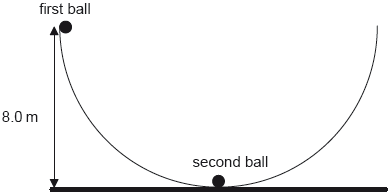| Date | November 2020 | Marks available | 2 | Reference code | 20N.2.HL.TZ0.1 |
| Level | Higher level | Paper | Paper 2 | Time zone | 0 - no time zone |
| Command term | Calculate | Question number | 1 | Adapted from | N/A |
Question
A company delivers packages to customers using a small unmanned aircraft. Rotating horizontal blades exert a force on the surrounding air. The air above the aircraft is initially stationary.
The air is propelled vertically downwards with speed . The aircraft hovers motionless above the ground. A package is suspended from the aircraft on a string. The mass of the aircraft is and the combined mass of the package and string is . The mass of air pushed downwards by the blades in one second is .
State the value of the resultant force on the aircraft when hovering.
Outline, by reference to Newton’s third law, how the upward lift force on the aircraft is achieved.
Determine . State your answer to an appropriate number of significant figures.
Calculate the power transferred to the air by the aircraft.
The package and string are now released and fall to the ground. The lift force on the aircraft remains unchanged. Calculate the initial acceleration of the aircraft.
Markscheme
zero ✓
Blades exert a downward force on the air ✓
air exerts an equal and opposite force on the blades «by Newton’s third law»
OR
air exerts a reaction force on the blades «by Newton’s third law» ✓
Downward direction required for MP1.
«lift force/change of momentum in one second» ✓
✓
AND answer expressed to sf only ✓
Allow from .
ALTERNATIVE 1
power ✓
✓
ALTERNATIVE 2
Power ✓
✓
vertical force = lift force – weight OR OR ✓
acceleration ✓
Examiners report
This was generally answered well with the most common incorrect answer being the weight of the aircraft and package. The question uses the command term 'state' which indicates that the answer requires no working.
The question required candidates to apply Newton's third law to a specific situation. Candidates who had learned the 'action and reaction' version of Newton's third law generally did less well than those who had learned a version describing 'object A exerting a force on object B' etc. Some answers lacked detail of what was exerting the force and in which direction.
This was answered well with many getting full marks. A small number gave the wrong number of significant figures and some attempted to answer using kinematics equations or kinetic energy.
HL only. It was common to see answers that neglected to average the velocity and consequently arrived at an answer twice the size of the correct one. This was awarded 1 of the 2 marks.
Well done by a good number of candidates. Many earned a mark by simply using the correct mass to find an acceleration even though the force was incorrect.


